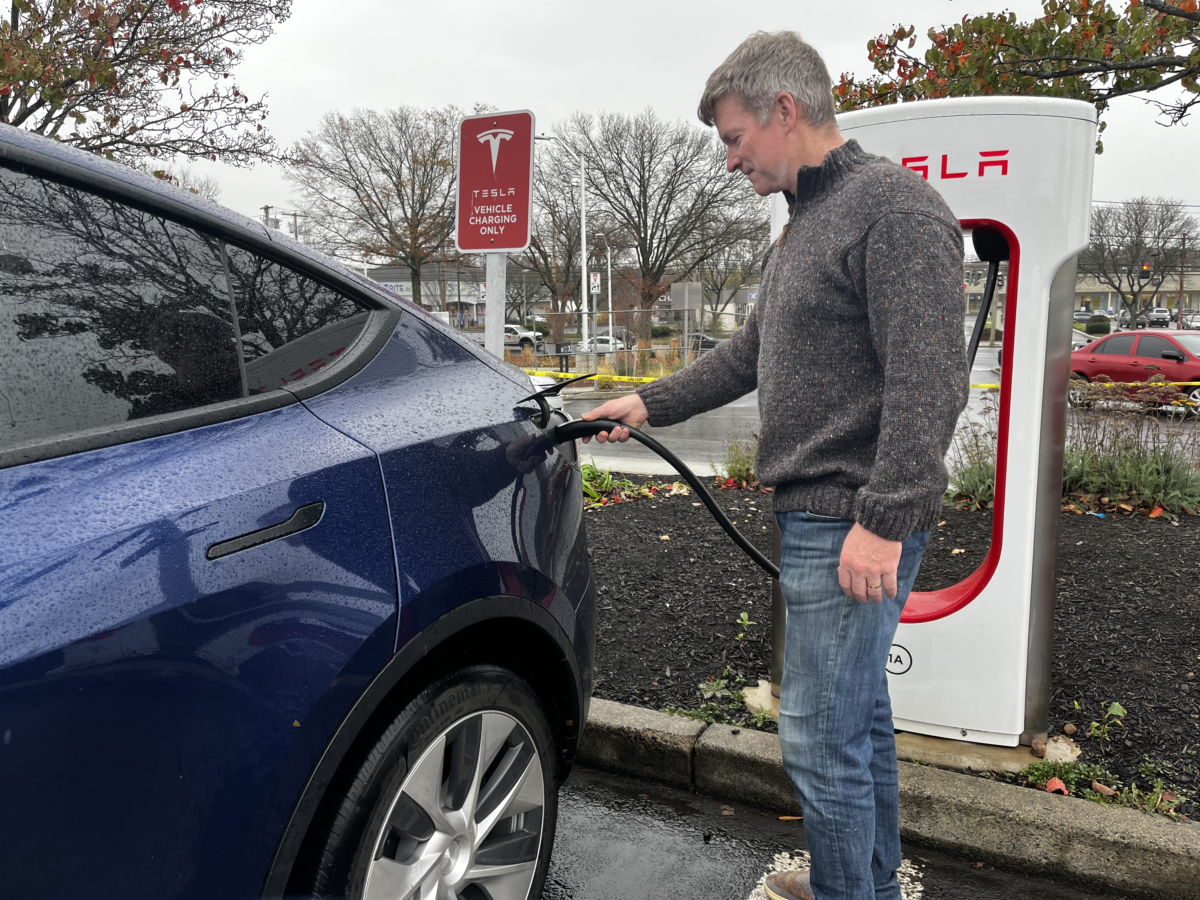Jeff Gross’ clothes matched his sporty car.
He wore a fedora with a plaid ribbon, a neutral button down shirt and long, tan shorts. He looked like a golfer and his car looked like it was too small to fit his golf equipment. He left for work, a 35-mile commute, folding himself over to get in the driver’s seat. He was aware his car “wasn’t designed to be practical; it was designed to be cute,” and he remembered that every day when he could not offer anyone a seat in the back.
Yet, “it’s adorable in its own way,” Gross said.
As he drove down the Hamden streets, he could not help noticing the rising gas prices. $3.57 per gallon on at Xpress Fuel on Dixwell Avenue, then just a few yards further $3.69 at the Mobile station, $3.79 at Shell and Gulf on Whitney Avenue, but $3.73 if you end up at Citgo back on Dixwell.
“Gas prices keep going up,” Gross said back in the end of September when filling up a 10-gallon tank of gas cost about $40. Since then gas prices fell in early October, but are back on the rise again.
Fortunately, Gross, a chapter leader of the Sierra Club, has not worried about this unlike 98% of Americans that own gas powered cars. Not only is Gross’ “mid-life crisis car” a 2023 green Mini Cooper S, it is an electric, green Mini Cooper S.

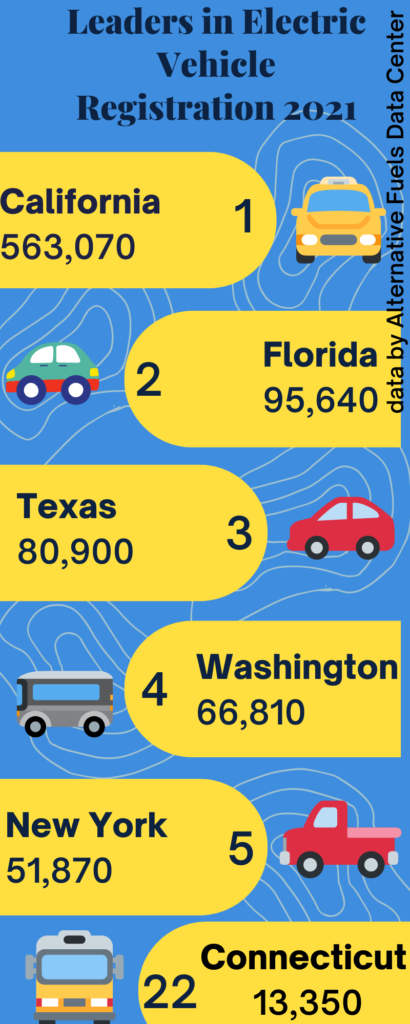
Though William Morrison, a chemist ahead of his time, invented the first American electric car in 1890, electric cars have only started regaining popularity recently, especially within the last four years. In 2017, roughly 200,000 electric cars were sold in the United States, which was a notable 25% increase in sales from 2016, an EV-Volumes report said.
That was a groundbreaking year in the electric vehicle community.
“If you thought it couldn’t get any better, we’ve only just begun,” Stephen Loveday, a contributing editor at Carfax and self described car lover, said on a blog post on Inside Evs.
This was proven right the next year. In 2018, over 360,000 electric cars were sold in the United States, an almost 75% increase from 2017, an Inside Evs report said.
California was a driving force amid this rise in the market, its citizens buying more than 40% of the electric cars sold in 2018.
Once again, California is set to lead the country in electric vehicle adoption.
California’s electric vehicle mandate
On August 25, the California Air Resources Board approved the Advanced Clean Cars II rule that sets a 10 year plan of phasing out the manufacturing of gas powered cars. Under this plan, “by 2035, 100% of new cars and light trucks sold in California will be zero-emission vehicles, including plug-in hybrid electric vehicles,” the California Air Resources Board said in its press release.
It is the most radical plan for electric vehicles by any state yet, putting pressure on the rest of the United States to consider the negative environmental impact of using gas powered vehicles.
The movement roots back to the Clean Air Act passed in 1963, enacting that the Environmental Protection Agency can enforce federal laws about air pollution from motor vehicles.
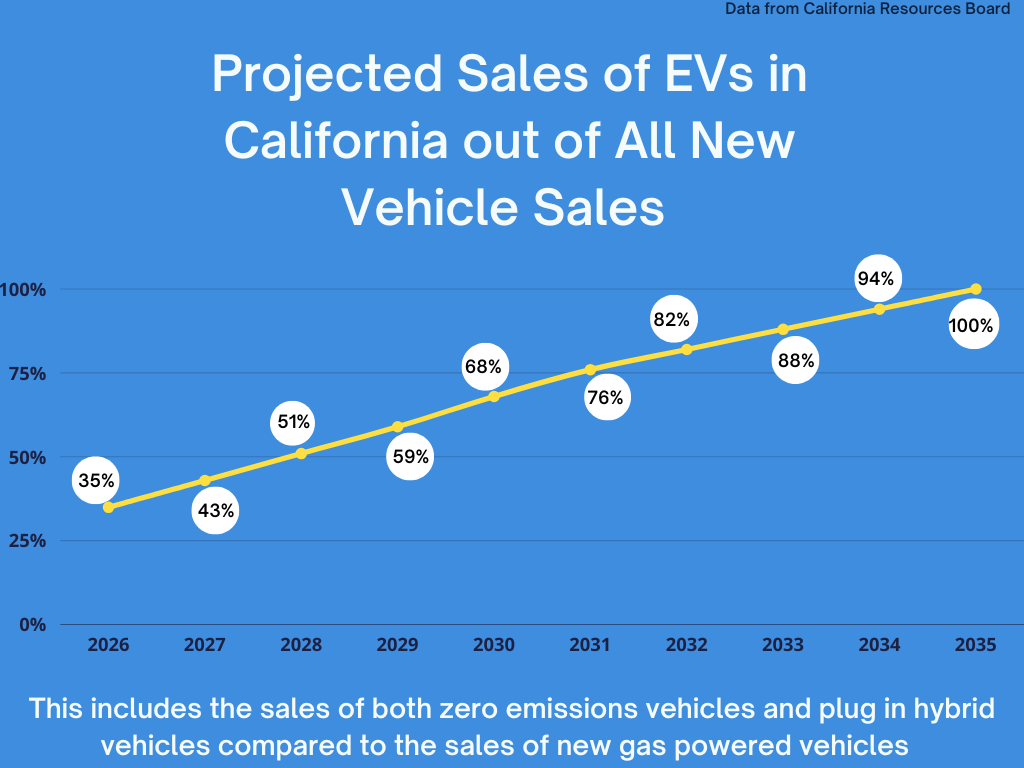
Since California already enforced rules to limit air pollution, the state was exempt from this act as long as their own laws met certain health standards. California then became the only state to be able to enforce its own laws regarding air pollution from motor transportation.
As of now, 12 states, including Connecticut, have followed California’s previous higher standards on pollution.
Since Connecticut followed California’s rule in 2004 to phase in lower emission cars and trucks to decrease greenhouse gas production, Connecticut is predicted to follow California’s current ruling about all new cars being electric or hybrid by 2035.
How California’s mandate affects Connecticut
Connecticut is already making strides to eliminate carbon emissions.
The state legislature passed Senate Bill 4, which fast-tracked some of the plans already in motion.
Under this new law, 100% of “state-purchased or state-leased” cars must be zero emissions by Jan. 1, 2030.
On Aug. 1, 2022, The Connecticut Department of Transportation announced the “Connecticut’s Charging Ahead Plan: A Strategy to Expand Public Electric Vehicle Charging.” With the plan, the National Electric Vehicle Infrastructure granted Connecticut $5 billion over the course of five years in order to install electric vehicle chargers every 50 miles.
“That’s a big deal,” Brendan Smith, a hybrid car owner and member of the energy use and climate change commission in Hamden, said about the new law.
It is a big deal as the main concern behind residents not wanting to buy an electric vehicle has to do with the limited range of the car and the limited number of charging stations to refuel.
Even Mayor Lauren Garrett, who owns two electric vehicles within her family, does not believe Hamden – or Connecticut in general – is prepared for such an undertaking.
“Hamden is not yet ready,” Garrett said after detailing the benefits of her Tesla model Y. “We just need more infrastructure for charging. We need more charging stations.”
Her high school-aged daughter drives a used, electric Ford Focus that cost less than $10,000, but only has a range of 70 miles.
Garrett, who had an electric charger installed at her house, likes that her daughter can’t go “too far,” no farther than 35 miles one way without worrying about refueling. But, that has forced her daughter to take a friend’s car for longer trips.
This is the exact fear of many hesitant car owners, which has led to compromises within the famiky. One member has the “road trip car,” the other has the more economical electric car.
Such is the case with Seth Hollande, who owns an electric 2016 Chevy Bolt, while his wife drives a hybrid car, powered by both electricity and gasoline, that has a longer range for trips.
Hollander has had this car for more than five years and knows the ins and outs of electric cars. He has gone through the trouble of the government locking him “out of the top 20% of my battery” as a safety measure to prevent fires, meaning he could only charge his car to 80% battery life and had to charge it again once it fell to 20%, but he has also enjoyed the benefits of an electric car.
“It just seemed like the thing to do considering the amount of driving I was doing, and the amount of maintenance I was putting in the car,” Hollander said about his decision to get an electric car in the first place. “I thought I’d take a chance.”
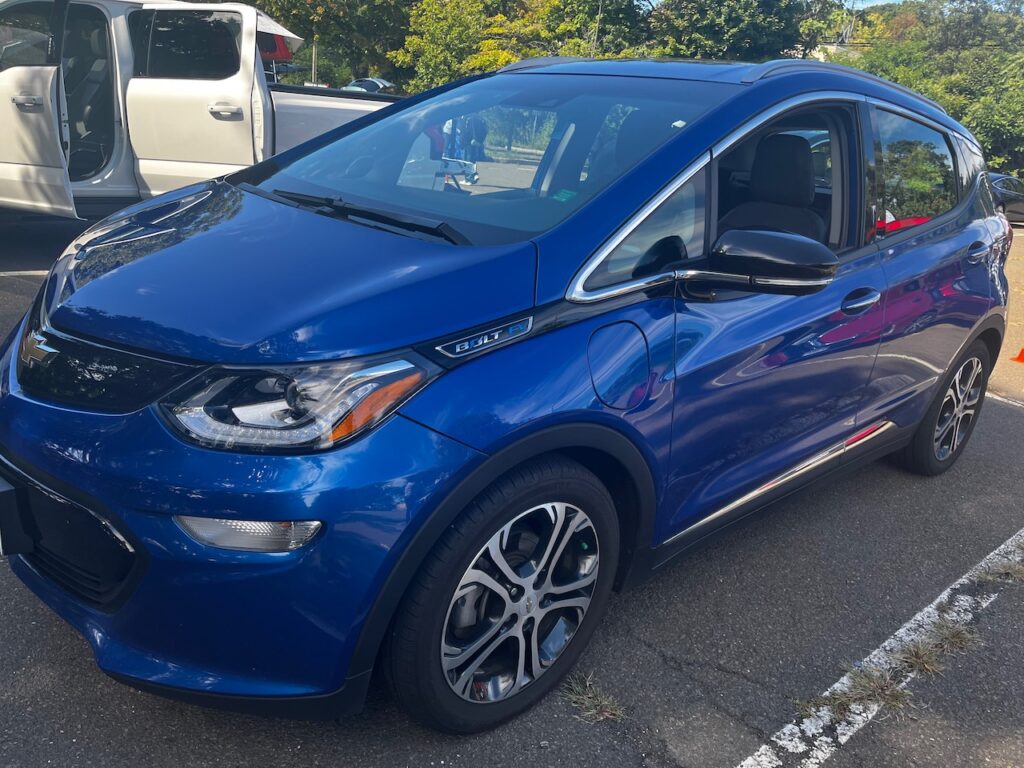
Hollander, whose previous car had to be “held together with twine” after he was driving 25,000 miles per year, was sick of car troubles. Now without the extra obstacles of a transmission and oil, maintenance has become easier and less costly.
He believes the infrequency of chargers only poses a problem if he doesn’t plan right.
“If I was in that desperate state of affairs (looking for a charging station), I really did poor planning,” Hollander said, though he says he is privileged to have a charger both at his work and at his home, where he can charge it overnight for the nine hours needed for a full tank.
The cost of electric vehicles
So what happens if one can’t afford an at home charger? That is the concern of many residents.
“I rent half of a two-family house with no garage. How on earth would I plug in a car? Run an extension cord out my window? Drive to a charging station every time I want to go somewhere?” Ariana Mongillo, a Hamden resident, said.
“The push for electric cars is such a privileged point of view.”
Ariana Mongillo
Though car companies usually supply a charger with every new electric car, it is usually a slower charger and installing a charger at a house usually entails hiring an electrician – also an added cost.
Geoff Gagnon who waited a year and a half for his electric 2022 Ford F150 pick-up truck estimated installing a charger cost him about $10,000. Now that it is installed, he can charge up his truck just like he charges his phone overnight. He leaves it charging for eight hours and wakes up to a truck that can drive 320 miles, tow a boat, and keep his beers cold.
“I love it. It’s kind of a dream vehicle,” Gagnon said. The “dream vehicle” is costly though, at $81,000 at the time Gagnon ordered it in 2021. The gas powered Ford F150 has a starting cost as low as $34,000 in comparison.
“It’s the cost of operation and comfort and technology,” he said.
Concerns about the impact of electric vehicles
There are many unsolved problems when it comes to electric vehicles.
There is the concern about costs, accessibility, electric fires firefighters are not yet trained for, the disposal of the batteries, the endurance of the batteries, the effect on the electric grid and the harmful way the materials for the batteries need to be mined.
There is a long list of cons, just as there is a long list of pros.
In spite of that, car manufacturers have made promises to do away with new gas-powered vehicles.
At the 2021 United Nations Climate Change Conference, Ford, General Motors, Mercedes-Benz, Volvo, Jaguar Land Rover and Chinese automaker BYD all signed a pledge to do away with the sale of new gas powered vehicles by 2040 globally.
Ultimately, despite reservations, leaders are pointing to electric vehicles as part of the solution for air pollution.
“It’s a great goal to have,” Connecticut State representative Joseph Gresko said of Connecticut adopting California’s law. “Whether or not Connecticut follows along, the market is dictating to take it (electric vehicles) seriously. We have time between now and then to fix the glitches and make sure the grid can sustain it.”
The grid is a concern for many residents also, but though the independent system operator of New England (ISO New England) has already made projections for how much energy electric cars will demand of them by 2030, there has been no mention of concern for the grid.
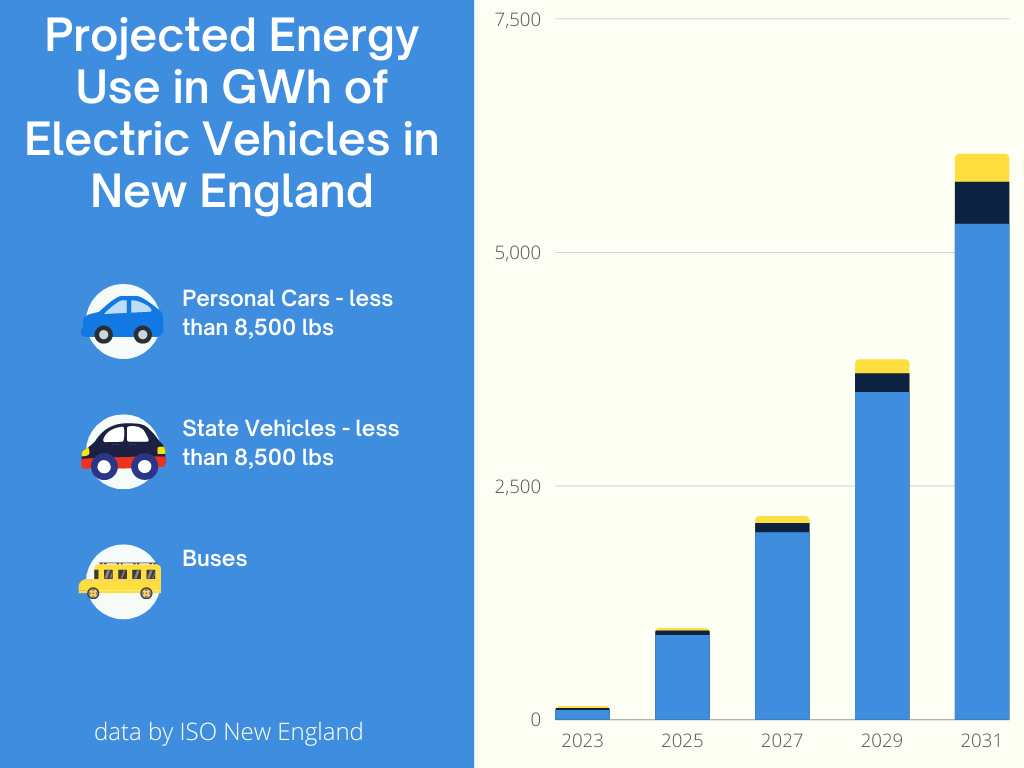
“As part of broader efforts aimed at anticipating future power system needs, we forecast electric vehicle adoption within the region over the next 10 years and how we’d expect that to impact the grid,” said ISO New England spokesman Matthew Kakley.
ISO New England’s projections show that by 2031, New England will increase to 164,965 gigawatts of annual electricity use due to the projected increase of electric vehicles, compared to this year’s projected electricity use of 140,536 gigawatts. ISO plans to combat these increases in electricity use by continuing incentives for renewable energy sources.
“In addition to electric vehicles, we forecast anticipated growth in solar energy, energy efficiency, and electric heating,” Kakley said.
As electric vehicles combat air pollution, ISO New England is trying to come up with ways to combat electric vehicles’ impact on the grid.
Ultimately, Connecticut legislation has a lot to consider when they consider following California’s electric car plan.
Electric cars seem to be a relatively new, shiny piece of technology no one knows the true impacts of yet. As electric car owners are happy with their decisions, gas powered cars are happy with their decisions to stay with the “practical” car.
Gross, the happy owner of a green Mini Cooper said, “The technology is compelling…you just need to be a little open. It’s a little bit of a cultural shift.”

